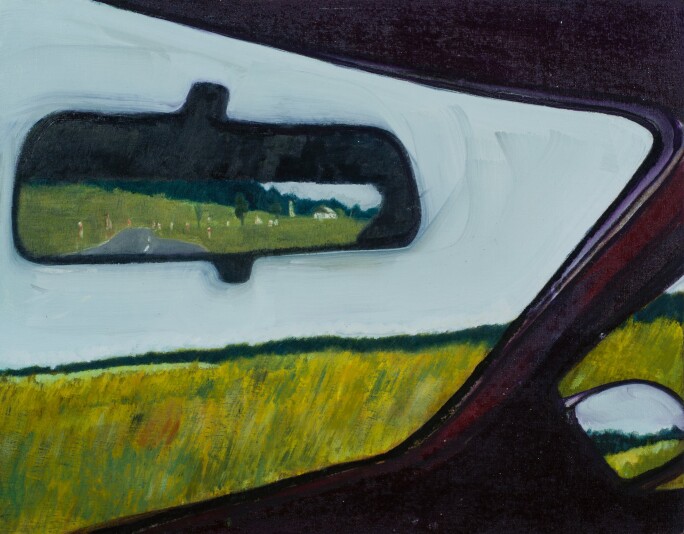I n 1972, sixteen-year-old Berg Johnson – a self-anointed “Caretaker of Dreams” – painted a rainbow over the grey façade of a roadside underpass on the outskirts of Toronto. Johnson was inspired by the memory of a friend, Sigrid, who had tragically died in a car accident nearby. He would often complain to her that people in Toronto “never looked up” and following her death he wanted to do something to make people smile.

It is Johnson’s rainbow tunnel, just off Toronto’s Don Valley Parkway, that we glimpse as if from the passenger seat of a passing car in Peter Doig’s Country-rock (wing-mirror), 1999. This mysterious landscape is distinctly Doig: characterised by his trademark otherworldliness and capturing the familiar ennui of such peripheral spaces.
Every time a major landscape by Doig is offered at auction it represents an important market moment: only last year, Swamped, 1990, established a new artist record of US$39 million. Replete with mystery and intrigue, Country-rock (wing-mirror) will be a highlight of Sotheby’s Hong Kong Contemporary Evening Auction this autumn, the most significant work by Doig to be offered at auction in Asia.
Between 1998 and 2000, Doig painted three monumental works centred on the same vista. One is held in the collection of the Pinchuk Art Centre, Kiev, while the other was chosen as the catalogue cover illustration for the artist’s landmark retrospective at Tate Britain in 2008 and remains in a European private collection.

OLE FAARUP COLLECTION, COPENHAGEN
© PETER DOIG. ALL RIGHTS RESERVED, DACS 2022
The present work is distinguished from the other two as the only version to feature a glimpse of the car – via the intrusion of a wing-mirror in the lower left quadrant. The spectator is thus a passenger on their way out of the sprawl and into the wild. Doig’s rainbow is a marker, a signpost for the wistful space of a summertime car journey, with the “country-rock” of the work’s title as its soundtrack.
Born in Edinburgh in 1959, Doig moved with his family to Trinidad in 1962, and then to Canada in 1966, where he spent the remainder of his childhood. He studied and launched his artistic career in London in the 1980s and 1990s, and now lives and works in Port of Spain, Trinidad. “I never felt that I belonged anywhere because we never lived in a house for more than three months”, Doig told The Guardian in 2013. “That's all I knew and that's why I don't really belong anywhere.”
Described as a painter of “elsewhere”, Doig’s subject is not the personal nostalgia of his nomadic life, but rather the concept of nostalgia itself. Doig uses the tale of the rainbow tunnel to conjure up a generalised sense of memory – a fleeting snapshot filled with implication, but devoid of direct connotation.

© PETER DOIG. ALL RIGHTS RESERVED, DACS 2022
In the transformation from concrete carbuncle to roadside symbol of hope, there is a pronounced folkloric dimension to the story that undoubtedly would have captured Doig’s imagination. Johnson, the “Caretaker of Dreams”, would determinedly return to the site more than 40 times over some 30 years to remove graffiti and restore his mural; a ritual that only ended when he was served with a no trespassing order in 1994. Today, it is officially protected as a celebrated local monument; a repository for 50 years worth of memories.
This nostalgia is not of the sickly-sweet kind. There is an atmospheric disturbance here that is present within the most powerful of Doig’s landscapes.
“A lot of the paintings portray a sense of optimism that can often be read as being a little desperate, like the image of a rainbow painted around the entrance to an underpass.”
In Doig’s words, these paintings “deal with peripheral or marginal sites, places where the urban world meets the natural world. Where the urban elements almost become, literally, abstract devices.”
In Country-rock (wing-mirror), telegraph poles cut through foliage and a concrete motorway courses through a verdant hillside. The rainbow itself recalls a trope from the Romantic landscapes of Caspar David Friedrich and JMW Turner, where it articulated divine glory. Here its role is distinctly postmodern, anchored to the artist’s own photographs of the tunnel taken years before the work was painted.

OIL ON CANVAS, 27 1/8 X 36 IN., 68.8975 X 91.44 CM., THE PHILLIPS COLLECTION, WASHINGTON, DC. ACQUIRED 1947.
© 2022 HEIRS OF JOSEPHINE N. HOPPER / LICENSED BY ARTISTS RIGHTS SOCIETY (ARS), NY
Doig was also thinking specifically about the Edward Hopper painting Approaching a City, 1946, in which a railway line moves inexorably towards the depths of a curved tunnel. The converging perspective and slight arch of the railway find an echo in the present work, as does the stark inference of isolation.
Autobiographically specific and culturally multifarious, this painting is definitive of the artist’s cinematic visual code; a melding of memory with imagination, landscape with dreamscape.







